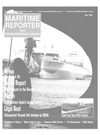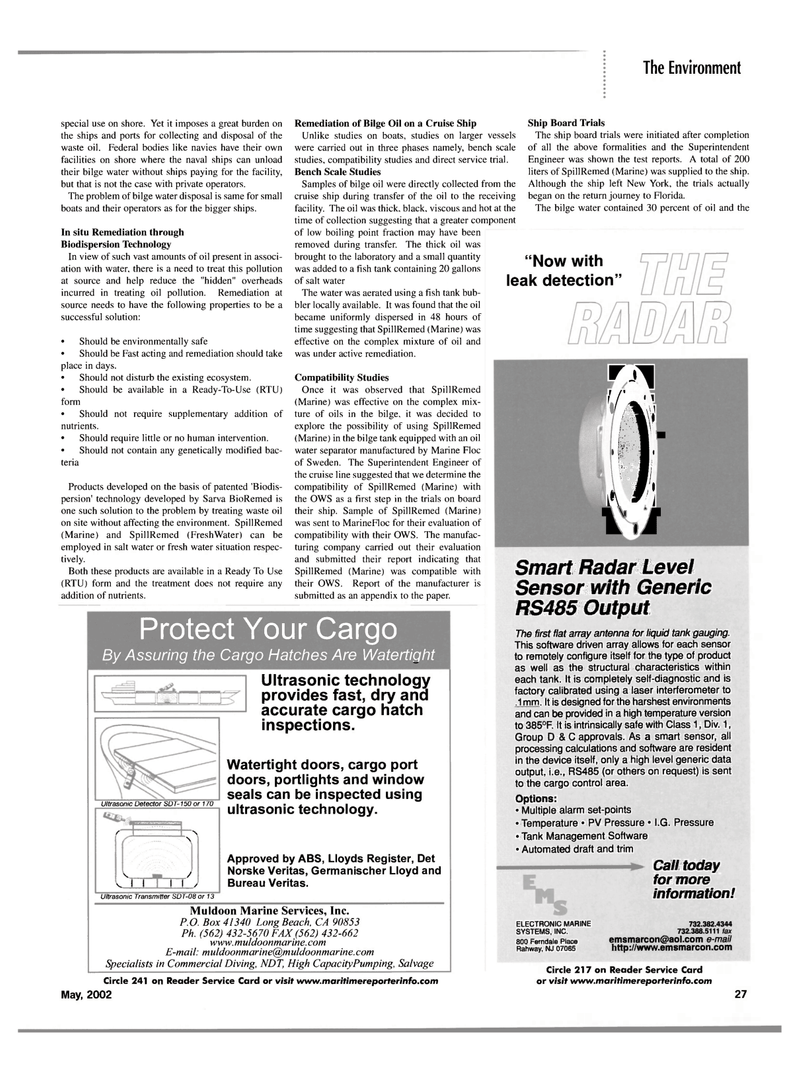
Page 27: of Maritime Reporter Magazine (May 2002)
Read this page in Pdf, Flash or Html5 edition of May 2002 Maritime Reporter Magazine
The Environment special use on shore. Yet it imposes a great burden on the ships and ports for collecting and disposal of the waste oil. Federal bodies like navies have their own facilities on shore where the naval ships can unload their bilge water without ships paying for the facility, but that is not the case with private operators.
The problem of bilge water disposal is same for small boats and their operators as for the bigger ships.
In situ Remediation through
Biodispersion Technology
In view of such vast amounts of oil present in associ- ation with water, there is a need to treat this pollution at source and help reduce the "hidden" overheads incurred in treating oil pollution. Remediation at source needs to have the following properties to be a successful solution: • Should be environmentally safe • Should be Fast acting and remediation should take place in days. • Should not disturb the existing ecosystem. • Should be available in a Ready-To-Use (RTU) form • Should not require supplementary addition of nutrients. • Should require little or no human intervention. • Should not contain any genetically modified bac- teria
Products developed on the basis of patented 'Biodis- persion' technology developed by Sarva BioRemed is one such solution to the problem by treating waste oil on site without affecting the environment. SpillRemed (Marine) and SpillRemed (FreshWater) can be employed in salt water or fresh water situation respec- tively.
Both these products are available in a Ready To Use (RTU) form and the treatment does not require any addition of nutrients.
Remediation of Bilge Oil on a Cruise Ship
Unlike studies on boats, studies on larger vessels were carried out in three phases namely, bench scale studies, compatibility studies and direct service trial.
Bench Scale Studies
Samples of bilge oil were directly collected from the cruise ship during transfer of the oil to the receiving facility. The oil was thick, black, viscous and hot at the time of collection suggesting that a greater component of low boiling point fraction may have been removed during transfer. The thick oil was brought to the laboratory and a small quantity was added to a fish tank containing 20 gallons of salt water
The water was aerated using a fish tank bub- bler locally available. It was found that the oil became uniformly dispersed in 48 hours of time suggesting that SpillRemed (Marine) was effective on the complex mixture of oil and was under active remediation.
Compatibility Studies
Once it was observed that SpillRemed (Marine) was effective on the complex mix- ture of oils in the bilge, it was decided to explore the possibility of using SpillRemed (Marine) in the bilge tank equipped with an oil water separator manufactured by Marine Floe of Sweden. The Superintendent Engineer of the cruise line suggested that we determine the compatibility of SpillRemed (Marine) with the OWS as a first step in the trials on board their ship. Sample of SpillRemed (Marine) was sent to MarineFloc for their evaluation of compatibility with their OWS. The manufac- turing company carried out their evaluation and submitted their report indicating that
SpillRemed (Marine) was compatible with their OWS. Report of the manufacturer is submitted as an appendix to the paper.
Protect Your Cargo
By Assuring the Cargo Hatches Are Watertight
Ultrasonic technology provides fast, dry and accurate cargo hatch inspections.
Ultrasonic Detector SDT-150 or 170 f > \
V, / ^ 1 1 i i ;
Ultrasonic Transmitter SDT-08 or 13
Watertight doors, cargo port doors, portlights and window seals can be inspected using ultrasonic technology.
Approved by ABS, Lloyds Register, Det
Norske Veritas, Germanischer Lloyd and
Bureau Veritas.
Muldoon Marine Services, Inc.
P.O. Box 41340 Long Beach, CA 90853
Ph. (562) 432-5670 FAX (562) 432-662 www. m uldoonmarine. com
E-mail: muldoonmarine@mitldoonmarine. com
Specialists in Commercial Diving, NDT, High CapacityPumping, Salvage
Ship Board Trials
The ship board trials were initiated after completion of all the above formalities and the Superintendent
Engineer was shown the test reports. A total of 200 liters of SpillRemed (Marine) was supplied to the ship.
Although the ship left New York, the trials actually began on the return journey to Florida.
The bilge water contained 30 percent of oil and the "Now with leak detection"
FjT^ ' / M
V v 1 H if:
WL \i M
ILiJ
Smart Radar Level
Sensor with Generic
RS485 Output
The first flat array antenna for liquid tank gauging.
This software driven array allows for each sensor to remotely configure itself for the type of product as well as the structural characteristics within each tank. It is completely self-diagnostic and is factory calibrated using a laser interferometer to .1mm. It is designed for the harshest environments and can be provided in a high temperature version to 385°F. It is intrinsically safe with Class 1, Div. 1,
Group D & C approvals. As a smart sensor, all processing calculations and software are resident in the device itself, only a high level generic data output, i.e., RS485 (or others on request) is sent to the cargo control area.
Options: • Multiple alarm set-points • Temperature • PV Pressure • I.G. Pressure • Tank Management Software • Automated draft and trim
ELECTRONIC MARINE
SYSTEMS, INC. 800 Ferndale Place
Rahway, NJ 07065
Call today for more information! 732.382.4344 732.388.5111 fax [email protected] e-mail http://www.emsmarcon.com
Circle 241 on Reader Service Card or visit www.maritimereporterinfo.com
May, 2002
Circle 217 on Reader Service Card or visit www.maritimereporterinfo.com 27

 26
26

 28
28
